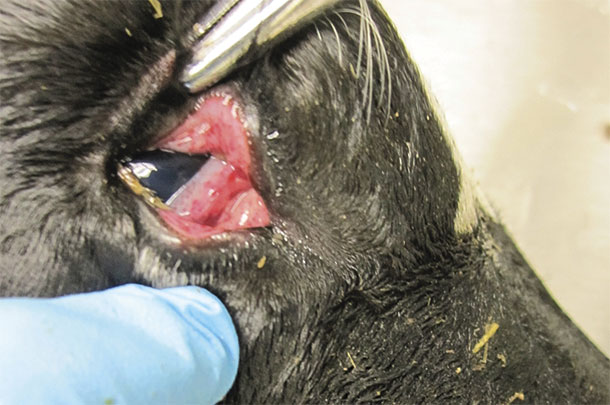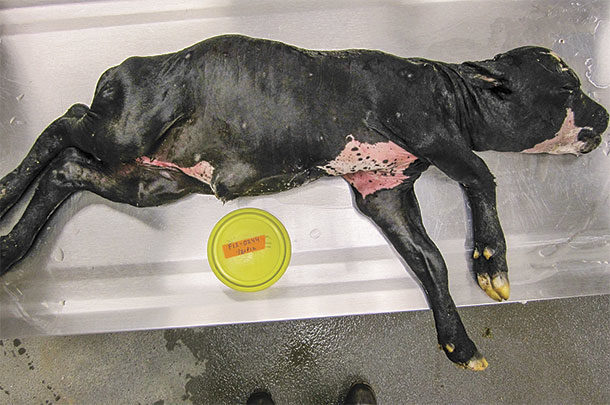The mysterious foothill abortion disease in cattle was first seen in the foothill regions of coastal and central California – and recognized in the 1940s as different from brucellosis. It also occurs in southern Oregon and Nevada. The pathogen that kills the fetus is transmitted by the bite of a soft-bodied tick called Ornithodoros coriaceus.
Dr. Jeffrey Stott, school of veterinary medicine at University of California, Davis, has studied this disease for years. The ticks that carry the bacteria live in arid regions, burrowing into the ground where deer or cattle bed. If they haven’t taken a blood meal for a month or more, they crawl out, locate the animal lying there and attach briefly to engorge with blood.
Unlike hard-bodied ticks that stay on the host for days or weeks, these soft-bodied ticks only need 30 minutes of attachment to fill up with blood. Then they drop off and burrow back into the ground. “Being rapid feeders, they don’t stay on the animal, so we rarely find these ticks on cattle,” says Stott.
They are very hardy and can withstand wildfires. “We’ve talked to ranchers who put cattle back on burned pastures after the grass recovered; they had increased incidence of foothill abortion. They can survive for two to three years without a blood meal and may live 12 to 20 years.”
Abortions from this disease are diagnosed with pathology. The aborted fetus has a unique lesion in the thymus. “This is a difficult disease to diagnose because predators are so prevalent that you rarely find the aborted fetus,” he says.
“The tick was identified as the vector in the 1970s, but it wasn’t until the mid-1990s that we finally identified the oddball bacteria. It’s a myxococcus in the family of deltaproteo bacteria, and recently named Pajaroellobacter abortibovis. It is difficult to culture; it won’t grow on any culture media. It only wants to live in ticks and replicates maybe once every few days, whereas most bacteria multiply rapidly,” he says.
“The only way we can grow these bacteria to study them is to grow them in mice that are genetically altered without an immune system. The only known naturally susceptible animal is a bovine fetus that does not yet have an immune system. It takes about as long to make an immune-deficient mouse sick (60 to 90 days) as it does to kill a fetus. If we infect a pregnant heifer, the earliest we get an abortion is about 100 days. This is why abortion occurs three to four months after being bitten by the tick,” he explains.
Some ranchers change breeding season to avoid overlapping the susceptible gestation period with tick exposure, or only using tick-infested pastures after cows are past six months of pregnancy. Exposed animals usually have immunity for a year or two, so some ranchers expose yearling heifers to tick-infested pastures before breeding to develop immunity before they are bred.
An alternate approach is to put off intentional exposure of pregnant heifers into the later months of gestation. “This has been fairly effective, so we did an experiment – infecting three heifers at five months’ and three heifers at seven months’ gestation. The seven-month gestation heifers all had healthy calves, but one of the five-month gestation infections resulted in abortion. This shows that at 150 days’ gestation they can still be susceptible,” Stott says.
A frustrating disease
“I think we see more abortions in the northeastern part of the tick’s range because replacement heifers in those regions are not getting sufficient exposure to be immune. Cattle are more naïve, and the ticks are hungrier because they’ve had a longer winter. Pregnancy losses on ranches we work with in the Alturas area, Klamath Basin and Lakeview occur in 40 to 60 percent of replacement heifers. By contrast, other areas where the ticks are not as bad, annual loss might be 10 to 15 percent,” says Stott.

“We’ve been working with a number of ranches for seven years, and the ranchers with relatively less annual foothill abortion might only lose 10 percent per year in first calvers, second calvers and some third calvers. This is probably because a certain percentage of the herd is still susceptible. Their total losses from foothill abortion are probably equal to the ranches that suffer the big wipeout in first calvers,” he explains.
“Ranchers in the Paso Robles area say they can manage the disease if they get their replacement heifers into tick-infested areas before they are bred. If they can develop immunity before they are bred, they have good luck – and then some years it doesn’t work, and this leaves us all shaking our heads. Every year is a little different; maybe the tick activity is different.”
Animals that abort breed right back again. “On a ranch that leaves bulls in all summer, you might not suspect you’d had abortions; you’d just have late-calving cows the next year. This is probably why we never recognized this aspect of foothill abortion early on,” says Stott.
The vaccine
Stott said development and testing on an experimental vaccine began seven years ago in collaboration with University of Nevada at Reno and its confined, naïve herd. The vaccine proved to be close to 100% efficacious in that situation.
More studies on a University of California ranch near Marysville, where ranchers experience foothill abortion, tested the vaccine there and received approval from the California Bureau of Animal Health and the USDA to work with seven private ranchers who had good management practices.
“This is the seventh year of trials, and in almost all the ranches north of us, we have stopped foothill abortion with the vaccine. The USDA approved our project. Expanded trials have been a collaboration between the California Cattleman’s Association (CCA) and the veterinary school here at Davis where we created the vaccine.”
An integral part of this program was to gather safety data to help facilitate obtaining a license for the vaccine. “Ranchers must keep records and give us some data back. Currently, we are vaccinating 10,000 to 12,000 cattle per year and getting inquiries from people who want to vaccinate heifers outside the classical foothill abortion region (California, Nevada and Oregon) so they can bring them into these areas as immune. That market had been eliminated by foothill abortion because if anyone brings a naïve herd into these regions, they abort – and not at a rate of 40 to 50 percent like the resident animals, but more like 85 percent,” he explains.
“I think there will be a good market for the vaccine. Trials will end in the spring of 2020 as the commercial product becomes available. We currently have to get state authorization and a USDA permit for every premises that we use the vaccine on.”
Vaccinated cattle seem to have immunity for at least two years, even in the absence of tick exposure. “Most cattle would be immune for up to three years. Somewhere during that time frame, they might need a booster if there is minimal tick activity. For resident animals in endemic areas, this will just be a heifer vaccine, which will largely protect the herd because those heifers will be immune as they work into the herd,” he says.
“We visited recently with the manager of a large ranch who was seeing losses at 10 to 15 percent from foothill abortion before we started vaccinating his cattle. This is the seventh year we’ve been vaccinating them, and he told me the abortions have largely ceased. Success of vaccine trials in commercial herds has been very encouraging,” Stott says. ![]()
PHOTOS 1 & 2: A foothill aborted fetus with enlarged fetal lesions, is pictured. Photos provided by Dr. Jeffrey Stott.
Heather Thomas is a freelance writer based in Idaho.









